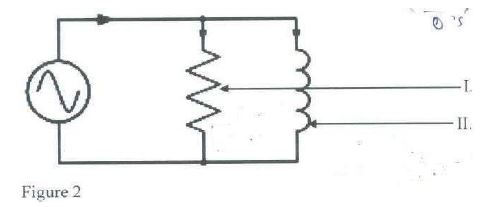<=Back
<=KNEC Craft Certificate in ICT module 1 Basic Electronics past paper: March 2023 with video(s)
Figure 2 represents a parallel circuit drawn by a student. Use it to answer the questions that follow.

I. Identify the components labelled (I) and (II)
II. Explain the behavior voltage across the circuit
I. Identify the components labelled (I) and (II)
II. Explain the behavior voltage across the circuit
Viewed: 550 times
For Better experience and learning,for video answers, after video ends playing, click next question in the questions list!!!
Share in:



Questions List:
1. Outline four disadvantages of an integrated circuit (IC).
2. With aid of a diagram, outline the circuit symbol for a PNP transistor showing the flow of current and voltages
3. Using one’s complement, calculate #11100001_2 - 10101111_2#
4. Draw the truth table for the OR gate
5. Explain two advantages of cache memory in computers.
6. Evaluate the following arithmetic, leaving the answer in octal number system i)#11101100_2 – 10111000_2# ii)#BC_16 + 57_8#
7. With aid of a diagram, outline the electronic configuration of silicon.
8. Determine the excess-3 equivalent for each of the following decimal numbers i)#71.6_10# ii)#945_10#
9. Explain two disadvantages of using hexadecimal number systems
10. Figure 1 represents a closed electric circuit of capacitors C1 (0.6uF), C2(0.3uF), and C3(0.9uF) and a charge of 10 coulombs. Use it to answer the question that follows. Determine the voltage in the circuit.
11. Define each of the following terms as used in basic electronics: I. Energy II. Amplitude III. Power dissipation
12. Explain two characteristics of ROM as used in computers.
13. Using karnaugh map, simplify the minimal terms using the four variables (ABCD) #sum(0,2,8,10,12)#
14. Using BCD, determine #81_10 + 77_10#
15. Outline three regions where a bipolar transistor has the ability to operate.
16. Differentiate between weighted code and nonweighted code as used in BCD number systems.
17. Simplify the decimal number #1- 7/8# , giving your answer in binary notation
18. Figure 2 represents a parallel circuit drawn by a student. Use it to answer the questions that follow. I. Identify the components labelled (I) and (II) II. Explain the behavior voltage across the circuit
19. List six types of diodes.
20. Differentiate forward biasing and reverse biasing of a p-n junction diode.
21. Outline three circumstances under which memory sticks could be used in computers.
22. Outline three uses of the octal number system.
23. Determine the colour code of each of the following carbon composition resistors: I. 13,000,000,000 ohms II. 97,000,000 ohms
24. A student noted types of rheostats in a laboratory while doing an experiment. Outline two such types.
25. Draw the logical gate used for the boolean expression
26. Explain two advantages of using BCD number systems.
27. Figure 3 represent a logic circuit. Use it to answer the question that follows. Draw a truth table for the logic circuit
28. Explain two circumstances that may necessitate the use of a gray code in computers, other than in karnaugh maps.
29. A circuit has a conductance of #4.2 times 10^-2# Siemens and voltage of 10 volts. Determine the current in circuit
1. Outline four disadvantages of an integrated circuit (IC).
2. With aid of a diagram, outline the circuit symbol for a PNP transistor showing the flow of current and voltages
3. Using one’s complement, calculate #11100001_2 - 10101111_2#
4. Draw the truth table for the OR gate
5. Explain two advantages of cache memory in computers.
6. Evaluate the following arithmetic, leaving the answer in octal number system i)#11101100_2 – 10111000_2# ii)#BC_16 + 57_8#
7. With aid of a diagram, outline the electronic configuration of silicon.
8. Determine the excess-3 equivalent for each of the following decimal numbers i)#71.6_10# ii)#945_10#
9. Explain two disadvantages of using hexadecimal number systems
10. Figure 1 represents a closed electric circuit of capacitors C1 (0.6uF), C2(0.3uF), and C3(0.9uF) and a charge of 10 coulombs. Use it to answer the question that follows. Determine the voltage in the circuit.
11. Define each of the following terms as used in basic electronics: I. Energy II. Amplitude III. Power dissipation
12. Explain two characteristics of ROM as used in computers.
13. Using karnaugh map, simplify the minimal terms using the four variables (ABCD) #sum(0,2,8,10,12)#
14. Using BCD, determine #81_10 + 77_10#
15. Outline three regions where a bipolar transistor has the ability to operate.
16. Differentiate between weighted code and nonweighted code as used in BCD number systems.
17. Simplify the decimal number #1- 7/8# , giving your answer in binary notation
18. Figure 2 represents a parallel circuit drawn by a student. Use it to answer the questions that follow. I. Identify the components labelled (I) and (II) II. Explain the behavior voltage across the circuit
19. List six types of diodes.
20. Differentiate forward biasing and reverse biasing of a p-n junction diode.
21. Outline three circumstances under which memory sticks could be used in computers.
22. Outline three uses of the octal number system.
23. Determine the colour code of each of the following carbon composition resistors: I. 13,000,000,000 ohms II. 97,000,000 ohms
24. A student noted types of rheostats in a laboratory while doing an experiment. Outline two such types.
25. Draw the logical gate used for the boolean expression
26. Explain two advantages of using BCD number systems.
27. Figure 3 represent a logic circuit. Use it to answer the question that follows. Draw a truth table for the logic circuit
28. Explain two circumstances that may necessitate the use of a gray code in computers, other than in karnaugh maps.
29. A circuit has a conductance of #4.2 times 10^-2# Siemens and voltage of 10 volts. Determine the current in circuit